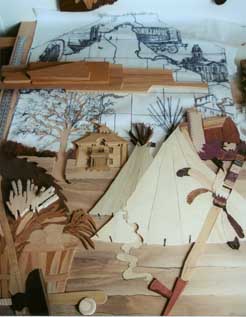
To call Caprice Glaser a woodworker might be accurate, but it’s a little like calling Hemingway a typist. Over the past 20 years, Caprice has obtained international recognition for her wood murals. You’ll find them in corporate lobbies, boardrooms, YMCAs, colleges, high schools, and private collections. Working from detailed drawings, Caprice meticulously cuts and fits together different kinds of wood into representations of history, culture, and portraits of the famous and not so famous.
One of her earliest pieces, “The Land,” is a large 9-by-30 foot mural created for St. Paul, Minnesota-based AgriBank. Using pictures from the farm magazines her neighbors loaned her, it took her a year to create. For over 20 years, the finished work hung in the skyway that went through the bank, enjoyed by generations of St. Paulites. When the bank recently moved to a new building, the mural was taken down and carefully reassembled, somewhat sadly for Caprice, out of the public eye.
Working in wood is just part of her repertoire. The St. Paul artist also finds time to work in stone, metal and even put a little paint on canvas. Step into her neat, small studio (she claimed she cleaned up for my visit), and you see just how busy and creative a person she is.
Taped to the wall, there’s a detailed pencil drawing of former Minnesota governor, Wendell Anderson, and nearby is the finished commissioned portrait. On her worktable, a large piece in progress for Dakota County.
Featuring important buildings, historic scenes, even a map; the piece will become the chimney on a “cabin” soon to display historical artifacts in the lobby of Hastings Government Center. There are many other drawings, gracefully sculpted marble or wooden pieces, paintings, models for works in metal and stone. Hanging from the ceiling is a large colorful fish, carved for fun out of Styrofoam. She recently worked on the set for the Guthrie Theatre’s production of “Antony and Cleopatra”. And in April, her recent paintings will be featured at a show at Phipps Center for the Arts in Hudson, Wisconsin.
For Caprice, there are no hard lines between these different media. Wood, stone or paint & she uses whatever’s required for the work. A graduate from the Art Institute of Chicago, her fine art background helps all her work come alive with color and activity.
In many ways, in fact, she really “paints” with wood. Her canvas is a piece of 3/4″ plywood. Her colors are oak, walnut, and padauk&along with 29 other varieties she’s used.
“And my brushstrokes are the grains of the wood,” she notes.
But before she cuts any wood, she starts with a drawing.
“I look at photographs and I may do two or three different drawings and then combine them into the final drawing. Contrast is so important and the drawings provide details and decisions about light and dark.”
Unlike the earlier large mural, Caprice doesn’t work flat anymore, but works with different thicknesses to give another dimension to the piece. That’s one reason she expects people to want to touch her work.
“I just finished a piece for the YMCA in St. Paul and I put extra wax on it.” She notes, “I just hope they vary the heights of the kids once in a while.”
Though she doesn’t consider herself to be a “tool person,” she uses belt and disk sanders, a grinder, and a Dremel for carving. But the tool she relies on is her Rockwell bandsaw.
“I use the bandsaw for 99% of my cuts. Many people ask if I use a scrollsaw & and I have one, but I do the tiniest pieces,1/8 x 1/4-inch pieces, with the bandsaw and though I’ve been nicked, I’ve never lost a finger.”
She buys her wood at Youngblood’s in Minneapolis, or people give it to her. She’s gotten Green Heart from South America, walnut was donated when she did a piece for the Boy Scouts, and she received walnut from the University of Wisconsin campus in Whitewater to use in a mural for the school.
“I have to have planed wood so I can see what I’m getting. I never stain it. Just use the natural color. I’ve developed my own system & for instance, using padauk for foliage, oak for the sky. And I make the grain match the contour of faces. I also understand that wood changes down the road — darkens, lightens — and I take that into consideration too.”
“Then to clamp the pieces down, I use everything& tape, clamps, weight it down & it’s something to see when it’s all clamped & and I use Titebond for my glue”
It all takes a lot of time.
“Somebody once suggested that I could increase my production by using a computer and a laser cutter.” Caprice recalled, “But then I wouldn’t be able to make all those decisions, and I really couldn’t do two of the same things.”





